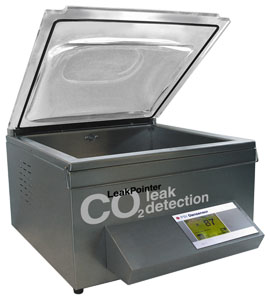Seal Integrity and Leak Detection of Modified Atmosphere Packaging Products

- Manual Trace Gas Leak Detection Based on CO2
- Read more about leak detection
It goes without saying that it is all useless if the package leaks! Leaks have been a thorn in the eye of the food industry for a long time and various tests are performed in order to check for leaks.
Water Bath
Traditionally, the method has been the water bath. The package is pressurised under water, either by squeezing the package by hand or by establishing a vacuum in the water container. A leak can then be detected by bubbles escaping through the leak due to overpressure in the package. The test is often performed with the same frequency as the head space test. A good idea is to run the leak test first and then subsequently perform the headspace test.
The problem with the water bath method for industrial use (other than being messy and not too hygienic) is that it is manual and thus it is difficult to repeat the testing conditions. Bubbles being detected during one test might not be discovered during the next test, even if the leaks are the same. Of course, the repeatability becomes better if the vacuum in the water tank is under strict control. Another problem is the discovery of the leak as bubbles from small leaks can be difficult to see. In other words, the quality of the water bath method highly depends on the person performing it and tested packages are difficult to reuse.

Trace gas leak detection based on the CO2 which is already present in the modified atmosphere packages makes trace gas leak detection more affordable than adding helium to the packages. CO2 based leak detection has a number of advantages:
Another trace gas method is hydrogen leak testing, however hydrogen is not a standard MAP gas and therefore gives added costs. Even more important is the fact that the readings of most gas analysers are affected by hydrogen, which means that it will not be possible to perform a correct residual oxygen measurement on the package if it contains hydrogen.
Read more about leak detectors.
Water Bath
Traditionally, the method has been the water bath. The package is pressurised under water, either by squeezing the package by hand or by establishing a vacuum in the water container. A leak can then be detected by bubbles escaping through the leak due to overpressure in the package. The test is often performed with the same frequency as the head space test. A good idea is to run the leak test first and then subsequently perform the headspace test.
The problem with the water bath method for industrial use (other than being messy and not too hygienic) is that it is manual and thus it is difficult to repeat the testing conditions. Bubbles being detected during one test might not be discovered during the next test, even if the leaks are the same. Of course, the repeatability becomes better if the vacuum in the water tank is under strict control. Another problem is the discovery of the leak as bubbles from small leaks can be difficult to see. In other words, the quality of the water bath method highly depends on the person performing it and tested packages are difficult to reuse.
Trace Gas Leak Detection
Another form of leak testing is the trace gas method, which is performed in a closed, airtight chamber. This means that if a leak is present and the gas escapes at a certain and precise vacuum, a gas sensor will now detect the concentration of the trace gas in the chamber. This method is extremely precise and can detect all relevant micro leaks.Trace gas leak detection based on the CO2 which is already present in the modified atmosphere packages makes trace gas leak detection more affordable than adding helium to the packages. CO2 based leak detection has a number of advantages:
Another trace gas method is hydrogen leak testing, however hydrogen is not a standard MAP gas and therefore gives added costs. Even more important is the fact that the readings of most gas analysers are affected by hydrogen, which means that it will not be possible to perform a correct residual oxygen measurement on the package if it contains hydrogen.
Read more about leak detectors.




